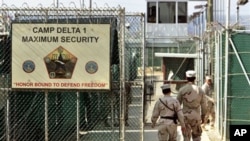Human Rights activists say the WikiLeaks Guantanamo documents show the United States has held hundreds of men at the facility for years with little or no hard evidence against them.
But, other experts say the previously secret risk assessment documents show the potential danger the men pose and the difficulty of figuring out who to hold and who to release.
When the United States was attacked on September 11, 2001, there was a rush to figure out who these terrorists were, how many there were, where they were and how to stop them. The effort included the U.S.-led invasion of Afghanistan and the detention of hundreds of Afghan and foreign fighters there and elsewhere.
In a fateful decision, U.S. officials decided to send some of the men to the U.S. Naval Base at Guantanamo Bay, Cuba, where facilities could be built to house them and they could be treated as ‘’enemy combatants’’, not exactly prisoners of war and also not under the jurisdiction of U.S. civilian courts, at least not initially. That gave U.S. military and intelligence interrogators a secure and relatively free environment in which to extract desperately needed information from the detainees.
Watch a Related Report by Carolyn Presutti
But that led to sub-standard living conditions for the early detainees, and years of harsh interrogations, legal complexities and international condemnations. These newly published documents shed some light on those years during the administration of former President George W. Bush, when the military created a process to determine which detainees to release and which to continue to hold.
"I think in a lot of ways that is the story of Guantanamo," said Shane Kadidal.
Shane Kadidal is a senior managing attorney at the Center for Constitutional Rights in New York.
"You throw a whole bunch of people in, with not really very much evidence at all to justify bringing them in in the first place, subject them to abusive interrogations for years, and then rely on things their fellow-detainees said about them to hold everybody," he said.
Kadidal and other legal experts and Human Rights advocates say the leaked documents show that many Guantanamo detainees were held based on thin evidence, and often based partly on things said by other detainees. He says detainee statements are notoriously unreliable, especially if they are made during abusive interrogation sessions. He says that is not a sufficient basis for extending a person’s detention.
"How can anybody say what someone is likely or not likely to do in the future, especially when they have such limited and unreliable information about what they’ve done in the past? It’s really a fool’s errand to try to make a reliable assessment about dangerousness," said Kadidal.
But at the conservative Heritage Foundation research organization in Washington, senior foreign policy analyst James Carafano says that is exactly what U.S. military panels must do to protect the United States from potential terrorists held at Guantanamo. And he says it is not accurate to assume that the secret ’’risk assessment’’ documents published this week are the only things on which detention decisions were made.
"They don’t necessarily represent all of the information that the U.S. government has on the detainees," said Carafano. "So, reading them, for example, would be like listening to one witness in a courtroom hearing and not listening to anything else and then determining a judgment. You wouldn’t do that."
But Carafano also acknowledges that trying to determine what someone might do in the future, based on what they did, or might have done, in the past is bound to be difficult.
"We knew it was very, very hard," he said. "The government has an obligation not to release anybody who could potentially attack the United States. A lot of that’s based on intent, so I don’t think it’s surprising necessarily that the government got part of the things wrong.’"
Of the total of 779 men held at Guantanamo since the detention facility was opened in 2002, 607 have been released or transferred to custody in their home countries. Estimates of how many of those have subsequently engaged in terrorism vary from a low of six per cent put forward by a liberal research organization, the New America Foundation, to a high of 25 per cent estimated by the chief of U.S. intelligence in December.
Pentagon spokesman Colonel David Lapan can not discuss details of the leaked documents because they are still technically classified. But he says they provide evidence of the type of challenges faced by the military officers who make detention decisions.
"It shows the difficulty of both this administration and the previous administration relying on all these bits and pieces of information from various sources on the battlefield and off in an effort to determine whether we can safely hold people or whether they can be repatriated, or returned, to their own countries," said Colonel Lapan.
And that leads some experts to conclude the United States must continue to hold some of the Guantanamo detainees because they are too dangerous to release, while others conclude the uncertainty means more men should be released, or at least given formal trials as soon as possible so the evidence can be evaluated in court.










